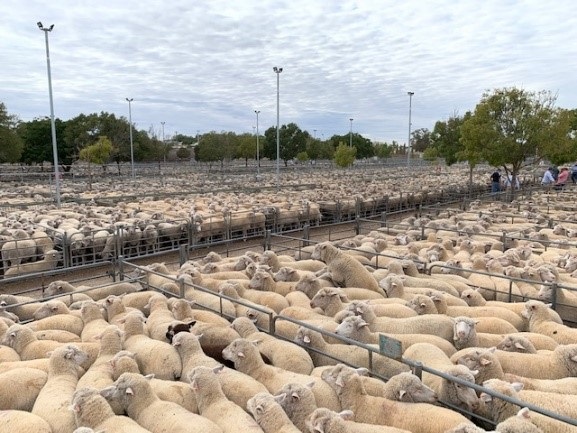
Ouyen’s saleyards was among several centres that offered more lambs later this week.
LAMB and sheep producers have been urged to stay calm and not flood markets with stock as the coronavirus COVID-19 pandemic impacts the supply chain.
Australian lamb and sheep prices have this week been hit by coronavirus-inspired producer concerns about price security and future demand, and processor’s cutting kills and splitting shifts.
Producers concerned about the impact of a global economic downturn on prices and demand due to the coronavirus COVID-19 pandemic have rushed lambs into saleyards and direct to works, in many cases earlier than otherwise planned.
This has happened just as some processors cut kill days due to price resistance and then also split shifts to lower the potential workforce impacts of a confirmed coronavirus case among staff.
These conditions have reduced saleyard trade competition for the increased yardings later this week, with processors dropping grid rates by up to 50c/kg, especially for heavy lambs, and prices dropping in some yards by up to $30 a head for heavy lambs and up to $40 for sheep.
After Thursday’s saleyard sales, the Eastern States Daily Indicator for heavy lambs dropped 8 cents to 915c/kg, back 41 cents for the week. The trade lamb indicator was down 7 cents to 941c/kg, 18 cents lower for the week. The ES mutton indicator lost 14 cents to close on 710c/kg, down 35 cents over the week. The ES Merino and light lamb indicators were both 10 cents lower, closing at 873c/kg and 953c/kg. Confidence in restocker lamb buying seemed unaffected, with the indicator rising 8 cents to 1030c/kg, although 18 cents lower week-on-week.
Rodwells manager urges calm among sellers
Rodwells Wimmera manager Wayne Driscoll said processors were only able to kill a certain number of lambs each day and if more than this were put on the market, there was a risk of prices being heavily reduced.
“The demand is still, there but they can only buy what they can kill each day with available staff at certain abattoirs.
“So our advice is to clients is to just go steady, just don’t rush into this like the stupid toilet paper thing, because while we remain a level of supply, rather than oversupply, we will be OK,” he said.
“But if we oversupply, they (the processors) can’t handle it.”
Mr Driscoll said some abattoirs are also splitting their workforce into different shifts to minimise any coronavirus case affecting the entire workforce.
“The government has told everyone in this sector that we’ve got to keep pushing forward — we’ve got to supply meat.
“So there is no issue there, but there is if we can’t supply meat.”
Mr Driscoll said the Horsham area normally sold more lambs at this time of the year as lambs come off stubbles.
“But last week was a bit of aberration — everybody just wanted to jump them all in — we think our numbers will go backwards next week.
“But they thing here is the abattoirs will tell your there is plenty of demand, but the uncertainty in production for the following day is the problem – the uncertainty of whether they have a workforce.”
Mr Driscoll said the empty meat shelves in supermarkets showed that panic buying was moving product “pretty quick.”
“The key point is if everyone just settles, and unless they are out of feed, just settle and then go from there, you will be ok.
“We basically need to keep a reasonable flow of livestock (into saleyards) and we will be ok, but if everyone wants to put everything in, we are going to have a problem.”
Until recently most sheep and lambs were going through the saleyards because of the high prices, but there had been “a little bit of a swing” back to direct consignments to abattoirs by producers seeking the “safety” of a known price, he said.
“The market has had massive swings – it was $40 cheaper (for mutton) in Hamilton yesterday.
Producer confidence in market wanes
Rodwells agent and president of the Wagga Wagga Selling Agents Association Ryan Schiller said the biggest concern among producers was about the ability of processors to move export lambs and mutton in the face of the COVID-19’s impact on global shipping and markets.
The Wagga saleyards yesterday continued the trend of other major markets during the week, yarding 35,800 lambs, 5800 more than last week, and 8000 sheep, 2000 more.
“No-one knows who is going to shut down or locked down or what is going to happen in the foreseeable future, so they are taking the opportunity while the money is good and not worry about things.
“There were a lot of store lambs here yesterday, so blokes are taking the money, thinking it is a long time till spring time, and let someone else worry about them,” Mr Schiller said.
“I think the bigger concern is being able to move product overseas, which has put a bit of a downturn into the export job.”
Processors not being able shift as much product at recent high prices and implementing shorter kill weeks was also part of the problem, he said.
“I think it is a supply issue, the numbers aren’t there and some of them aren’t willing to pay the rates and are slowing down a bit to two or three days a week, to keep the works going.”
However, Mr Schiller said prices were still good.
“There is not too much wrong with 850-900 cents a kilogram for lamb – the $10 was good, but it was realistically unsustainable, you could say.
“Blokes deserved the big money, for they put into lambs this year, but realistically if you can get around that 900-950c/kg it’s not too bad a rate.”
Mr Schiller said Wagga district producers were also weighing up their options, with ewes starting to lamb, they are starting to focus on the next drop of lambs.

HAVE YOUR SAY